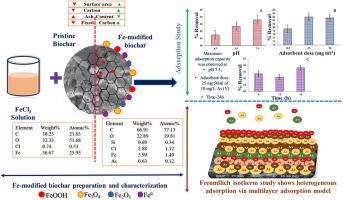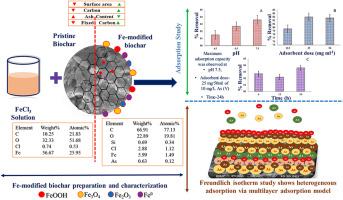利用脱油薄荷生物质生物炭去除砷:吸附动力学和铁改性的作用
IF 10
1区 环境科学与生态学
Q1 ENGINEERING, ENVIRONMENTAL
引用次数: 0
摘要
水中的砷污染威胁着全球数百万人的健康,因此需要制定可持续的有效补救策略。这项研究探讨了利用从去油薄荷废料中提取的铁改性生物炭(MMBC)去除砷(V)的问题。研究旨在合成 MMBC 并评估其吸附能力;其次,研究吸附动力学;最后,阐明该过程背后的调节机制。近似分析表明,MMBC 具有稳定性(低水分:6.48%,高固定碳:54.7%)和高吸附潜力(低挥发性物质:9.77%)。表征技术(SEM-EDX、XRD、傅立叶变换红外光谱、TGA)证实了理想的多孔结构、有利的化学成分以及对吸附 As(V)至关重要的表面功能。重要的是,与未改性的生物炭相比,MMBC 的表面积更大,提供了更多的活性位点(378.08 m2 g-1)。在操作条件方面,pH 值为 7.5 时,MMBC 的用量为 25 毫克/50 毫升,接触时间为 24 小时,As(V)的去除效果最佳。此外,动力学模型显示了一种伪二阶机制,表明化学吸附是主要过程。不过,等温线研究显示了有利的多层吸附,Freundlich 模型对数据的描述最好。MMBC 的多孔性、功能基团和铁改性的共同作用促进了物理和化学吸附机制。这些发现凸显了 MMBC 作为生物炭基吸附剂的潜力,可高效去除受污染水体中的 As(V),实现可持续修复。本文章由计算机程序翻译,如有差异,请以英文原文为准。


Arsenic removal using de-oiled mentha biomass biochar: Adsorption kinetics and the role of iron modification
Arsenic contamination in water threatens millions of people globally, demanding the development of sustainable and effective remediation strategies. This work investigates the removal of As(V) using Fe-modified biochar derived from de-oiled Mentha waste (MMBC). The study aimed to synthesize MMBC and evaluate its adsorption capacity; secondly, to investigate adsorption kinetics; and lastly, to elucidate the governing mechanisms behind the process. Proximate analysis revealed MMBC's stability (low moisture: 6.48%, high fixed carbon: 54.7%) and high adsorption potential (low volatile matter: 9.77%). Characterization techniques (SEM-EDX, XRD, FTIR, TGA) confirmed a desirable porous structure, favorable chemical composition, and surface functionality critical for As(V) adsorption. Importantly, MMBC exhibited a significantly larger surface area providing more active sites (378.08 m2 g⁻1) as compared to the unmodified biochar. Concerning operational conditions, the optimal As(V) removal was achieved at pH 7.5 with a 25 mg/50 mL MMBC dosage in a 24 h contact time. Further, kinetic modelling indicated a pseudo-second-order mechanism, suggesting chemisorption as the dominant process. However, isotherm studies revealed favorable multilayer adsorption, with the Freundlich model best describing the data. The combined effects of MMBC's porosity, functional groups, and Fe modification facilitated both physical and chemical adsorption mechanisms. These findings highlight MMBC's potential as a promising biochar-based adsorbent for efficient As(V) removal from contaminated water for sustainable remediation.
求助全文
通过发布文献求助,成功后即可免费获取论文全文。
去求助
来源期刊

Journal of Cleaner Production
环境科学-工程:环境
CiteScore
20.40
自引率
9.00%
发文量
4720
审稿时长
111 days
期刊介绍:
The Journal of Cleaner Production is an international, transdisciplinary journal that addresses and discusses theoretical and practical Cleaner Production, Environmental, and Sustainability issues. It aims to help societies become more sustainable by focusing on the concept of 'Cleaner Production', which aims at preventing waste production and increasing efficiencies in energy, water, resources, and human capital use. The journal serves as a platform for corporations, governments, education institutions, regions, and societies to engage in discussions and research related to Cleaner Production, environmental, and sustainability practices.
 求助内容:
求助内容: 应助结果提醒方式:
应助结果提醒方式:


